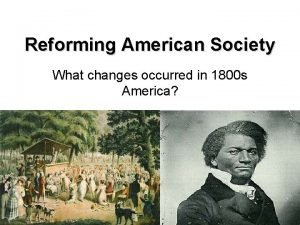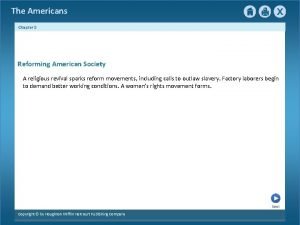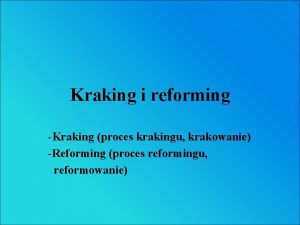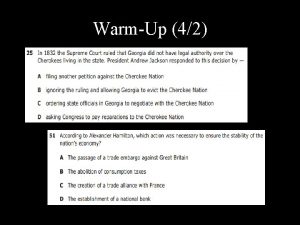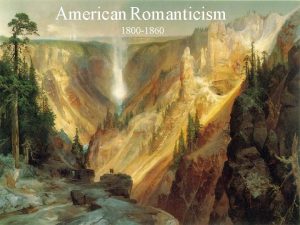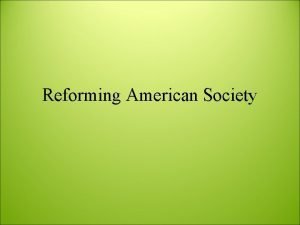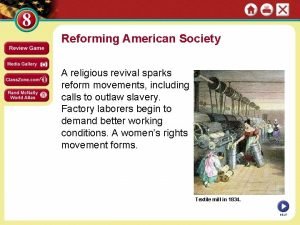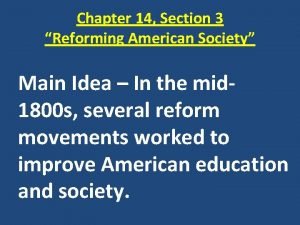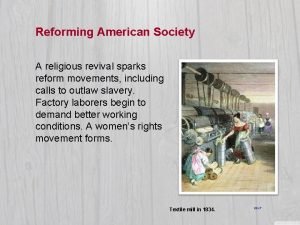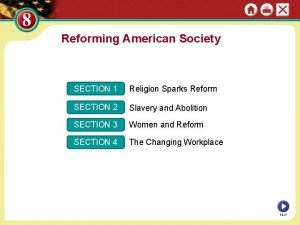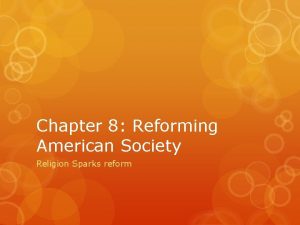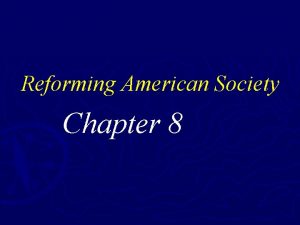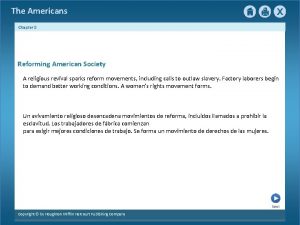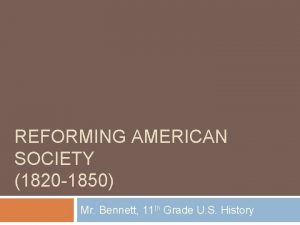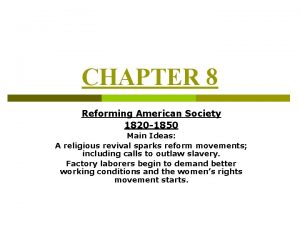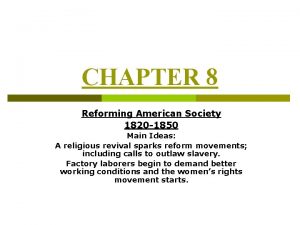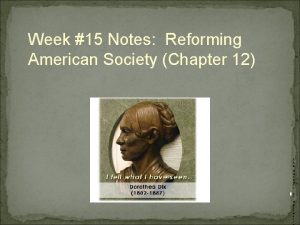Reforming American Society Warmup In the 1800 s






















- Slides: 22

Reforming American Society Warmup: In the 1800 s Americans tried to reform things they saw as damaged… IN your groups or solo Think of 3+ Issues or problems in the USA or even here AT GCIT that need to be improved on or “fixed” Also for each of your three PRoblems propose a possible solution. Bonus create a Visual Image illustrating a needed Reform…. .

Reforming American Society A religious revival sparks reform movements, including calls to outlaw slavery. Factory laborers begin to demand better working conditions. A women’s rights movement forms. Textile mill in 1834. NEXT


Sec 1 a Religion Sparks Reform The Second Great Awakening Religious Activism • Second Great Awakening—religious movement, sweeps U. S. after 1790 • Individual salvation depends on his/her own efforts • Large gatherings; some preachers get 20, 000 or more at outdoor camps Revivalism Image • Revival—gathering to awaken religious faith; lasts 4 to 5 days • Revivalism greatly increases church membership Continued. . . NEXT

SECTION 1 Transcendentalism and Reforms Transcendentalism • Ralph Waldo Emerson leads group practicing transcendentalism: - literary and philosophical movement - emphasizes simple life - truth found in nature, emotion, imagination • Henry David Thoreau puts self-reliance into practice, writes Walden • Thoreau urges civil disobedience, peaceful refusal to obey laws Image https: //www. youtube. com/watch? v=ZQcb. A 5_Ga. SE NEXT

Section 1 b Slavery and Abolition As religion is revived…. Slavery becomes an explosive issue, as more Americans join reformers working to put an end to it. NEXT

Slavery and Abolitionists Speak Out The Resettlement Question • 1820 s over 100 antislavery societies advocate resettlement in Africa • Most free blacks consider themselves American; few emigrate • Whites join blacks calling for abolition, outlawing of slavery William Lloyd Garrison • William Lloyd Garrison—radical white abolitionist; founds: - American Anti-Slavery Society • The Liberator calls for immediate emancipation— freeing of slaves Image Continued. . . NEXT

continued Abolitionists Speak Out Free Blacks • David Walker advises blacks to fight for freedom, not wait to get it • Frederick Douglass • worked as urban slave, Frederick Douglass: taught to read, write by owner’s wife • Douglass escapes; Gives lectures for Anti-Slavery Society • Douglass Publishes a newspaper The North Star: widely read in the North Image NEXT

continued Life Under Slavery Urban Slavery • Demand in southern cities for skilled black slaves • Slave owners hire out their workers to factory owners • Treatment of slaves in cities less cruel than on plantations Nat Turner’s Rebellion • Nat Turner, preacher, ; led a rebellion of slaves and free blacks in Southampton County, Virginia on August 21, 1831, about 60 whites killed • Turner, followers, innocent are captured; at least 200 killed in retaliation NEXT

Slave Owners Defend Slavery Virginia Debate • Virginia legislature debates abolition; motion not passed • Ends the debate on slavery in antebellum (pre-Civil War) South As Abolitionists Movement gained strength in the North in the South states began to unify in their defense of slavery. Continued. . . NEXT

Vlas: 2 nd Great Awakening: https: //www. youtube. com/watch? v =Sjt 392 m 36 yo Fredrick Douglass: https: //www. youtube. com/watch? v =0 Hi 4 j. IZg 0 c. I Nat Turner: https: //www. youtube. com/watch? v =4 Oad 2 t. Y-RPc

Journal/Discussion Warmup: • 1. Are Men and Women TRULY equal today? Why or Why Not? • 2. Would you rather go to a high School for all boys? (if you’re a boy) Or to an All girls school? (if you are a girl) Or Should High schools stay mixed as most are now? • What are some advantages and disadvantages are there to same sex schools?

Section 2 Women Reformers And The Changing Workplace Women reformers expand their efforts from movements such as abolition and temperance to include women’s rights. Also a growing industrial work force faces problems arising from manufacturing under the factory system NEXT

Women’s Roles in the Mid-1800 s Cultural and Legal Limits on Women • Cult of domesticity—the name for: Customs that controlled the lives of Many women (only housework, child care for married women • women earn half of men’s pay for doing same job • Women: few rights; cannot vote, or sit on juries • married woman’s property, earnings belong to her husband • Elizabeth Cady Stanton, Lucretia Mott form women’s rights society (NAWSA) NEXT

SECTION 3 Women Mobilize for Reform Women joined Abolitionists • Middle-class white women inspired by religion join reform movements • Grimké sisters — work for abolition - daughters of Southern slave owner Working for Temperance • Many women joined a temperance movement— prohibit drinking alcohol • Widespread use of alcohol in early 19 th century • American Temperance Society founded 1826; 6, 000 local groups by 1833 Image Continued. . . NEXT

SECTION 3 continued Women Mobilize for Reform Education for Women • Until 1820 s, few opportunities for girls past elementary school • - 1837, Oberlin College admits 4 women; first coeducational college • Other women only schools begin to open… Would you rather be a school of all boys or all girls or mixed as it is now? Continued. . . NEXT

continued Women Mobilize for Reform Women and Health Reform • Elizabeth Blackwell, doctor, opens clinic for women, children • Catharine Beecher’s national survey finds most women unhealthy • Amelia Bloomer rebels, designs loose pants; popular with other women NEXT

Women’s Rights Movement Emerges Seneca Falls • Reform encourages women’s movement, • 1848, Stanton, Mott hold Seneca Falls Convention for women’s rights • “Declaration of Sentiments” modeled on Declaration of Independence Sojourner Truth • Former Northern slave Sojourner Truth travels country preaching • Later argues for abolition, women’s rights Continued. . . NEXT

Industry Changes Work Rural Manufacturing • Cottage industry—manufacturers supply materials, goods made in homes • 1830 s Entrepreneurs like Francis Cabot Lowell open weaving factories in MA Image • Factories revolutionize industry: cost of household items drops • With machines, unskilled workers replace artisans Continued. . . NEXT

Workers Seek Better Conditions Workers Unionize • Artisans form unions; begin to ask for better wages and safe working places • 1830 s– 1840 s, 1– 2% of workers organized, dozens of strikes - employers use immigrants as strikebreakers Chart Continued. . . NEXT

SECTION 4 continued Workers Seek Better Conditions National Trades’ Union • 1830 s, unions for same trade unite/ standardize wages, conditions • 1834, organizations from 6 industries form National Trades’ Union : *** unusual because it represented a variety of occupations! • courts declare strikes illegal (Strikes take place across Nation against unfair conditions…. Factory owners say strikers could be arrested!) • In 1842, Massachusetts Supreme Court upholds right to strike in Commonwealth v Hunt NEXT

VLA reviews: 1. Seneca Falls https: //www. youtube. com/watch? v=KWTq 2 Xcf. RE 2. 2. Lowell MA factory town: https: //www. youtube. com/watch? v=b. F 7_Z 2 eu -c. Y https: //www. youtube. com/watch? v=pk. Jw. OYagvu. I 3. Strikes!: https: //www. youtube. com/watch? v=x. Ph. LKARAve 4 4. Commonwealh v Hunt This is the end of the chapter presentation of lecture notes. Click the HOME or EXIT button.
 Reforming american society
Reforming american society Chapter 8 reforming american society
Chapter 8 reforming american society American romanticism 1800 to 1860 worksheet answers
American romanticism 1800 to 1860 worksheet answers American romanticism 1800 to 1860 worksheet answers
American romanticism 1800 to 1860 worksheet answers Romantic period in american literature
Romantic period in american literature American romanticism 1800 to 1860 worksheet answers
American romanticism 1800 to 1860 worksheet answers American literature 1750 to 1800
American literature 1750 to 1800 Pyramid warmup
Pyramid warmup Ethos warmup
Ethos warmup Warmup 65
Warmup 65 Rhyme glow
Rhyme glow Tinman running calculator
Tinman running calculator Gmass warmup
Gmass warmup Multiplication properties of exponents
Multiplication properties of exponents 65 mins
65 mins Status vs class
Status vs class Define:warmup
Define:warmup Java warmup
Java warmup Warmup ratio
Warmup ratio Warmup end
Warmup end Chapter 25 section 4 reforming the industrial world
Chapter 25 section 4 reforming the industrial world Catalytic reforming of hexane
Catalytic reforming of hexane Bottleneck reaction
Bottleneck reaction
